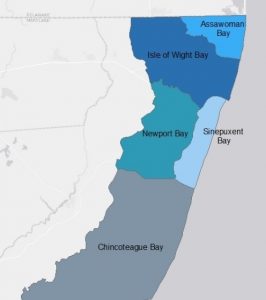In 2015, the Center for Watershed Protection led the development of a watershed-based plan focused on meeting the nonpoint source TMDL load reductions from the Maryland portion of the Coastal Bays watersheds in Maryland, which include Assawoman Bay, Isle of Wight Bay (including the St. Martin’s River), Sinepuxent Bay, Newport Bay and Chincoteague Bay. The plan addresses the 16 waterbodies with approved TMDLs for nutrients and/or sediment in the Coastal Bays watershed and identifies current and future BMPs to reduce pollutant loads in each TMDL subwatershed. This project involved identification and mapping of existing and proposed BMPs, a desktop assessment to identify additional opportunities to install BMPs, and pollution reduction estimates. Results were compiled into a final watershed plan that was structured to follow the nine elements for watershed planning known as the “a-i criteria” that were established by the U.S. EPA guidance to address non-point source management measures. Although this plan primarily focused on establishing strategies for reducing pollutant loads from nonpoint sources, it also documents reductions achieved (or planned) from point sources, which could potentially provide the basis for nutrient trading opportunities in the future.
In 2019, the Center completed an update to the 2017 plan that primarily focused on adding in new information from watershed stakeholders on BMPs installed since the TMDL baseline. This included agricultural BMPs reported by Maryland Department of Agriculture, urban BMPs (e.g., stormwater retrofits, storm drain cleanouts) from a variety of sources, other BMPs such as stream and wetland restoration, shoreline/riparian projects, and septic upgrades and connections. The nutrient load reductions associated with these management measures were calculated, primarily using documented crediting protocols from the Chesapeake Bay Program. A proposed strategy to meet the remaining required nitrogen load reduction for Assawoman Bay is also included in this plan. The Center is currently working with the Maryland Coastal Bays Program through a separate contract to refine the suite of proposed BMPs based on discussion with watershed stakeholders and field assessments to identify and estimate pollutant load reductions associated with specific BMP opportunities.
The 2019 Maryland Coastal Bays Watershed Plan is available on the Maryland Department of the Environment’s website. Funding for the plan was provided by EPA through Worcester County Department of Environmental Programs. To learn more about this project, contact Karen Cappiella at kc@cwp.org.






